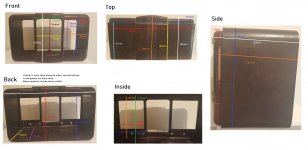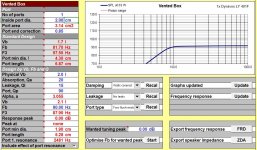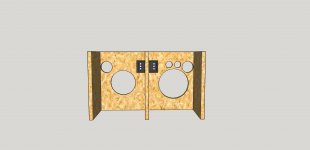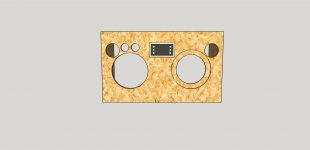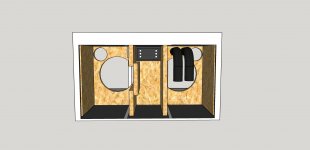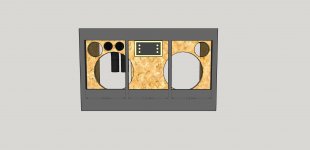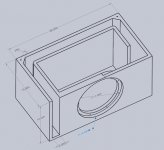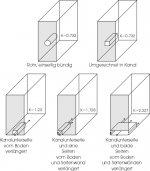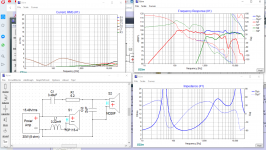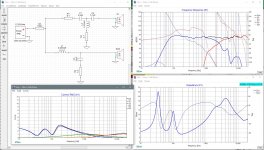@jReave @Douglas Blake
When I was doing my initial review of different drivers, this one did come up as an option:
Dayton Audio DSA90-8 3" Designer Series Aluminum Cone Full-Range Driver 8 Ohm
Its 3 inch, goes down to 66Hz, but would probably still benefit from a tweeter in the high range because it gets a bit shitfaced after ~3kHz
Can the faceplate of a tweeter be removed without damaging the integrity of the speaker?
Thanks for the suggestions
When I was doing my initial review of different drivers, this one did come up as an option:
Dayton Audio DSA90-8 3" Designer Series Aluminum Cone Full-Range Driver 8 Ohm
Its 3 inch, goes down to 66Hz, but would probably still benefit from a tweeter in the high range because it gets a bit shitfaced after ~3kHz
Can the faceplate of a tweeter be removed without damaging the integrity of the speaker?
Thanks for the suggestions
Also, yeah totally open to looking at a new tweeter. I havnt bought any of this gear yet, so its ll negotiable
The DSA90-8 doesn't look too bad but I'd probably go with the Dayton ND91-4 if I was going to go with a smaller driver. Attached below is a comparison of the TCP115 vs the DSA90 vs the ND91-4 all in about 2L. The DSA has more limited SPL capabilities whereas the ND91's have 4.6mm of xmax but 25mm of mechanical excursion which means that you can pretty much push them to their max power limits (30W) with all frequencies and not worry about blowing them up. The trouble with these tiny monsters though is that they need pretty long ports, like 22 - 25cm but that can be done I think because I calculated that you have about 3L per speaker of volume to play with in that radio setup.
Some tweeter faceplates can indeed be modified. Best if they can be removed to do so and also best if they are flat, ie are not performing some kind of waveguide function which it looks to me like the Dayton ND28F is doing, albeit mildly.
Looks like choices might depend on how you intend to fit everything into that enclosure. Are you trying to get something else in between the speaker cabs? Is that where the amp will go? Or can you fit a thin and wide amp across the width of the unit below the speaker cabs at the bottom and therefore allow the cabs to be wider?
The TCP with a tweeter without a faceplate I think could fit your narrow 150mm preference. The ND91-4 would definitely do so, maybe even with a larger tweeter. I'd work with the layout of what you are trying to achieve and try to decide what's going to fit and then move forward from there.
Some tweeter faceplates can indeed be modified. Best if they can be removed to do so and also best if they are flat, ie are not performing some kind of waveguide function which it looks to me like the Dayton ND28F is doing, albeit mildly.
Looks like choices might depend on how you intend to fit everything into that enclosure. Are you trying to get something else in between the speaker cabs? Is that where the amp will go? Or can you fit a thin and wide amp across the width of the unit below the speaker cabs at the bottom and therefore allow the cabs to be wider?
The TCP with a tweeter without a faceplate I think could fit your narrow 150mm preference. The ND91-4 would definitely do so, maybe even with a larger tweeter. I'd work with the layout of what you are trying to achieve and try to decide what's going to fit and then move forward from there.
Attachments
This little four incher with a wizzer cone from Parts Express might be worth considering.
Also, very retro, fitting in with the cabinet... 😉
Also, very retro, fitting in with the cabinet... 😉
Last edited:
@Waxx
Thanks for the suggestions, unfortunately, none of them would fit in the space that im trying to get these speakers into. Please see the image attached for the dimensions of the radio shell im wanting the speakers to fit into.
With such a small enclosure you will never have bass i'm affraid, even with the drivers you first mentioned. I would go for a pair of 3" fullrangers, one on each side and seal the box.
That Dayton ND91-4 can work in it, but only sealed with an F3 of 139Hz and it's upper range is a bit ragged. I would not use this driver without a tweeter, it's more a midbass than a fullrange driver.
I would rather go for a Tang Band W3-2141 (similar priced as the Dayton). it's bass response and xmax is less (F3 of 150Hz), but in such a small enclosure it makes a little difference. The top is way better what is more important here i think. It fits the enclosure (size and parameter) if you make it sealed, and you can add two, one on each side. No crossover is needed, just couple your amp direct to the speaker. And if you want bass, you can add a subwoofer in an other enclosure later on (or now). This enclosure will never give real bass, with any driver, also because it's made of thin plastic.
With such a small enclosure you will never have bass i'm affraid, even with the drivers you first mentioned. I would go for a pair of 3" fullrangers, one on each side and seal the box.
That's true, it looks to be a bakelite case which was notorious for vibrating with sound. One workable solution here is the 4" dayton I suggested in my last post, but not in a sealed box... in a box using pegboard as a back panel (probably like the original radio) This provides a semi-open baffle that should provide some degree of reasonable bass.
You might also be surprised to see what some people interpret as Bass... I've heard truly rumbling bass solos that when run through a spectrum analyser didn't have a single note below 120hz.
Some time with a signal generator and a good speaker can be very informative about what low end frequencies actually sound like, and the limits of our hearing. (For example: I don't hear anything under about 44hz, but I do feel it down to about 18hz on my eardrums and sinuses.)
Last edited:
That's true, it looks to be a bakelite case which was notorious for vibrating with sound. One workable solution here is the 4" dayton I suggested in my last post, but not in a sealed box... in a box using pegboard as a back panel (probably like the original radio) This provides a semi-open baffle that should provide some degree of reasonable bass.
I would also not use that case, it will surely vibrate. But the OP wants it so...
You might also be surprised to see what some people interpret as Bass... I've heard truly rumbling bass solos that when run through a spectrum analyser didn't have a single note below 120hz.
Some time with a signal generator and a good speaker can be very informative about what low end frequencies actually sound like, and the limits of our hearing. (For example: I don't hear anything under about 44hz, but I do feel it down to about 18hz on my eardrums and sinuses.)
Ears only hear bass untill arround 60Hz, everything below is felt with your diaphragm, and therefor need a certain volume to be heared. And we have mental tricks in our instinct to suggest bass when we hear overtones, so the bass is not there but we think that it is...
But it's true that many recordings especially older ones have next to nothing below 50Hz. Even the most bass heavy music of analog times like jamaican and UK dub have nothing under 32Hz, and that was exceptional. The lowest note on a standing bass (aka double bass) or an standard electric bass is at 41Hz, and on a low tuned (B0) 5string bass it's 30.87Hz. That last one is very rarely used, so for most flat below 40 gives everything. With synths we can go lower off course...
And humans hear nothing below 12Hz, then it becomes an earthquake like feeling (even on low level).
That Dynavox looks like a decent choice. Vented response is below showing max SPL and an F3 of 88Hz. It's a little bit of a compromise on the LF extension but it looks like it doesn't need a tweeter and therefore no xo. Max SPL is with only 3W which means you can get away with a less powerful amp too.
I'm going to disagree slightly with a couple of points raised. No reason for the radio shell to vibrate excessively if you use some damping material between it and the speaker cabinets.
And yes, you are never going to get the same bass from a 3" or 4" driver as with a much larger one, but from reports of the TCP115 and from my own personal experience with the ND91-8, you will be pleasantly surprised at how well these little drivers perform in the low end. If you use them, go vented not sealed. Up to you of course how low you want the speakers to go for casual listening. An F3 of 70-80Hz can be totally adequate for many people. Lower than that though and you are going to need to go with larger drivers or a separate subwoofer.
I find it always helps to define your design goals/parameters as soon as you can - things like F3, max SPL, minimum impedance, budget and so on. It helps making driver choices a little bit easier.
I'm going to disagree slightly with a couple of points raised. No reason for the radio shell to vibrate excessively if you use some damping material between it and the speaker cabinets.
And yes, you are never going to get the same bass from a 3" or 4" driver as with a much larger one, but from reports of the TCP115 and from my own personal experience with the ND91-8, you will be pleasantly surprised at how well these little drivers perform in the low end. If you use them, go vented not sealed. Up to you of course how low you want the speakers to go for casual listening. An F3 of 70-80Hz can be totally adequate for many people. Lower than that though and you are going to need to go with larger drivers or a separate subwoofer.
I find it always helps to define your design goals/parameters as soon as you can - things like F3, max SPL, minimum impedance, budget and so on. It helps making driver choices a little bit easier.
Attachments
I would also not use that case, it will surely vibrate. But the OP wants it so...
Some no-res might help...
Ears only hear bass untill arround 60Hz, everything below is felt with your diaphragm, and therefor need a certain volume to be heared. And we have mental tricks in our instinct to suggest bass when we hear overtones, so the bass is not there but we think that it is...
Exactly ... with age and hearing damage, that even tends to creep up a bit.
But it's true that many recordings especially older ones have next to nothing below 50Hz. Even the most bass heavy music of analog times like jamaican and UK dub have nothing under 32Hz, and that was exceptional. The lowest note on a standing bass (aka double bass) or an standard electric bass is at 41Hz, and on a low tuned (B0) 5string bass it's 30.87Hz. That last one is very rarely used, so for most flat below 40 gives everything. With synths we can go lower off course...
Yep... for a real experience you need to run a signal generator through a sealed box speaker (to avoid the port cancellations). It's really very informative to realize just how bloody low pitched 60 hz is.
And humans hear nothing below 12Hz, then it becomes an earthquake like feeling (even on low level).
True, if it's strong enough we feel it. The room feels haunted... like there's a presence.
Then there's THIS The Windsor hum... I was one of the first to track it down to the steel rolling plant on Zug Island. Spotted it by different wave patterns in the Detroit river around the island, it was driving people crazy.
Last edited:
Not sure if it was clear, but im planning to build a speaker box and put that in the bakerlite shell. Im aware that thin plastic would be a terrible choice for a speaker box. And yeah, im already planning to line the inside of the bakerlite with something to give it some strength (bakerlite is notoriously brittle especially once old). So i can just as easilly choose something to pad the gaps with and reduce any rattle. Maybe some sort of polyfill or a good quality bit of foam. To be honest, its not meant to be the worlds most amazing set of speakers. Its meant to be a stylish and nice sounding device to let me listen to music while i do some other projects. Its also a way for me to dip my toes into electronics and learn some stuff. Otherwise id just buy a bluetooth speaker. God knows it would have been cheaper rofl.
What is the advantage of going a ported speaker over a sealed or even passive radiator setup? As i understand it, it offers more bass, but in return, it ends up being alot bigger yes? So If my biggest concern is the size, why wouldnt i pick a slightly bigger driver with better low and mid range that will fit in a sealed or passive radiator enclosure of the size I want? Price is not a huge issue for me. The reason i picked cheaper drivers is because all small drivers are cheap as far as i can tell.
What is the advantage of going a ported speaker over a sealed or even passive radiator setup? As i understand it, it offers more bass, but in return, it ends up being alot bigger yes? So If my biggest concern is the size, why wouldnt i pick a slightly bigger driver with better low and mid range that will fit in a sealed or passive radiator enclosure of the size I want? Price is not a huge issue for me. The reason i picked cheaper drivers is because all small drivers are cheap as far as i can tell.
Ported gets a lower F3 than a sealed box but needs more internal volume. A passive radiator is essentially the same as a ported box, it's just using a resonant membrane instead of a port to get the same extra LF output. Passive radiators can be a good choice when the particular driver you are working with needs an excessively long port, which is often the case with smaller drivers that are designed to go low in small vented boxes like the Dayton ND91's for example. But the passive radiator usually needs to be slightly larger than the driver it's used with, so in your case, you would be running into problems with where to fit it in your proposed design - possibly on the sides in which case you would need to cut holes into the sides of the radio shell.
For this project, I would set minimum design goals of F3 = 80Hz, max SPL of about 90dB at 1m for musical content above 40Hz (that's a minimum for the max SPL - yes I know it may sound confusing) and drivers (and port opening?) that are going to fit within a 140mm (ht) x 150mm (wdth) baffle (or can you go wider than that? I'm still not sure). I think your max internal volume is about 3L gross but I'm not 100% sure about that either.
Going back a few pages now, I think the Dayton TCP115 and a smaller diameter tweeter can meet the above criteria. But there have also been some other suggestions made since then too that can work. I think it's kind of up to you which way you want to go now, so if you still can't decide, maybe try to figure out what it is you need to know that will help and ask those questions (if that's not perhaps stating the obvious?😱).
Should I also mention that if I'm trying to build an upper echelon speaker, I'm not confident to just rely on xo simulations? Real in-room and on-baffle measurements are required here. But for a very casual listening speaker, it doesn't need to be perfect and so in this case I am confident to say that we should be able to come up with a simulated xo without measurements that you can be happy with if you want to go that route.
For this project, I would set minimum design goals of F3 = 80Hz, max SPL of about 90dB at 1m for musical content above 40Hz (that's a minimum for the max SPL - yes I know it may sound confusing) and drivers (and port opening?) that are going to fit within a 140mm (ht) x 150mm (wdth) baffle (or can you go wider than that? I'm still not sure). I think your max internal volume is about 3L gross but I'm not 100% sure about that either.
Going back a few pages now, I think the Dayton TCP115 and a smaller diameter tweeter can meet the above criteria. But there have also been some other suggestions made since then too that can work. I think it's kind of up to you which way you want to go now, so if you still can't decide, maybe try to figure out what it is you need to know that will help and ask those questions (if that's not perhaps stating the obvious?😱).
Should I also mention that if I'm trying to build an upper echelon speaker, I'm not confident to just rely on xo simulations? Real in-room and on-baffle measurements are required here. But for a very casual listening speaker, it doesn't need to be perfect and so in this case I am confident to say that we should be able to come up with a simulated xo without measurements that you can be happy with if you want to go that route.
Not sure if it was clear, but im planning to build a speaker box and put that in the bakerlite shell. Im aware that thin plastic would be a terrible choice for a speaker box. And yeah, im already planning to line the inside of the bakerlite with something to give it some strength (bakerlite is notoriously brittle especially once old). So i can just as easilly choose something to pad the gaps with and reduce any rattle. Maybe some sort of polyfill or a good quality bit of foam.
There is a product called No-Rez that comes in small sheets. It is sticky on one side and foam on the other. It's also a good inside liner in your speaker boxes. Alternatively small pads of cork will work almost as well.
To be honest, its not meant to be the worlds most amazing set of speakers. Its meant to be a stylish and nice sounding device to let me listen to music while i do some other projects.
This is why I suggested the little 4 inch driver with the whizzer cone. It's super easy to work with... no crossover needed, and having heard them before I think the result will be just fine for you. Also that type of speaker was common in radios of that vintage, so it would not not be off-theme for your project.
The way these were usually used was with a pegboard back on the cabinet. That is as a semi-open-baffle design. They did it out of cheapness, but in your case it could be a very good idea since, again, it's easy to implement and it will sound ok.
As has been pointed out before, in a cabinet that small with stereo speakers you really can't expect a whole lot of hifi sound. But my memory of those old phillips and rca radios is that, given the era, they actually sounded pretty good.
What is the advantage of going a ported speaker over a sealed or even passive radiator setup?
Lower bass extension... about half an octave is typical. You should read the other messages were we talked about that. I'm betting that if you get the bass in that radio down to 100hz you're going to be perfectly happy with the sound of it... many (dare I say "most"?) recordings have very little if any content under 80hz anyway.
Thanks for the info guys. For the record, the 150mm thing is because the bluetooth/radio/AUX decoder i bought for the system is 80mm wide. So 150mm gives enough room for me to have that at the front in the middle, and a speaker either side of it. Additionally, I figure that would leave enough room between the boxes for any other electrical components i need such as an amp or a crossover (If one ends up being used). Also, 150mm is the external width, including the materials used to make the spoeaker box.
The problem with a port is that the radio is only about 160-178mm deep. So unless I want the speakers hanging out the back, thats how far back the speakers can go. Like I said, i could probably compromise and see them coming out the back a couple of cm if i needed to, but a 22cm port would really start to impact on the aesthetic of the piece. So if its possible to fit a passive radiator at the back instead, then we can keep the speaker box a bit smaller and it doesnt need to poke out the back of the radio shell. At 150mm wide, I should be able to fit a 5inch passive radiator at the back of the enclosure no problem yes? Does that sound feasible? If not, then i probably have no choice but to ditch the 4 inch drivewrs which at least narrows my options.
The problem with a port is that the radio is only about 160-178mm deep. So unless I want the speakers hanging out the back, thats how far back the speakers can go. Like I said, i could probably compromise and see them coming out the back a couple of cm if i needed to, but a 22cm port would really start to impact on the aesthetic of the piece. So if its possible to fit a passive radiator at the back instead, then we can keep the speaker box a bit smaller and it doesnt need to poke out the back of the radio shell. At 150mm wide, I should be able to fit a 5inch passive radiator at the back of the enclosure no problem yes? Does that sound feasible? If not, then i probably have no choice but to ditch the 4 inch drivewrs which at least narrows my options.
There are some very good 3" full range drivers available. If you can accept a separate woofer enclosure you could have higher volume levels and more bass.
I would recommend putting the unit up against a wall. This will have less baffle step loss which means it will play a little louder which means you need slightly less amp power all other things being equal.
In this situation, it's best for the ports or passive radiators to be in the front or side. For the passive radiators, that doesn't really work for your design. For the ports, it's not a problem on the front as you can easily just put a bend in a port to have it fit within the dimensions you've outlined as long as there is actually enough room for them on the front baffles.
Not exactly ideal, but if you do keep the unit a few inches out from the wall, rear ports or passive radiators will work more or less. So up to you on that one.
I understand your thinking a little better from your last post and drew up a quick sketch to see if the the TCP115 and a tweeter and ports will fit and indeed they do. (Pics 1 and 2 - top, bottom and back left off for visibility) Front baffle space is limited so I shrunk the port diameter to 2cm and used 2 of them. Port length is 18cm for each. Wood thickness is 12cm which I think would be fine in this application.
However, there is actually a fair amount of wasted interior space in the design. You don't actually need to house the amp etc in a separate exterior space. Instead I would suggest simply using 1 interior box, spit down the middle for the left and right channels. (Pics 3 and 4) Make it as big as you possibly can in the space you are working with. Seal the Bluetooth controller off if you have to and just include the rest of the electronics in either chamber.
My rough calculations suggest you might be able to get about 10 or 11L out of it and be able to fit just a slightly bigger diameter woofer on the baffle, up to about 130mm or so. And that opens up the possibility of several other drivers that can work for you that can probably play both louder and lower. Maybe better quality too.
Digest that. If that last idea works for you, maybe try to figure out a more precise estimate of the max internal volume you will have for each driver and then we can possibly make further driver recommendations for you.
In this situation, it's best for the ports or passive radiators to be in the front or side. For the passive radiators, that doesn't really work for your design. For the ports, it's not a problem on the front as you can easily just put a bend in a port to have it fit within the dimensions you've outlined as long as there is actually enough room for them on the front baffles.
Not exactly ideal, but if you do keep the unit a few inches out from the wall, rear ports or passive radiators will work more or less. So up to you on that one.
I understand your thinking a little better from your last post and drew up a quick sketch to see if the the TCP115 and a tweeter and ports will fit and indeed they do. (Pics 1 and 2 - top, bottom and back left off for visibility) Front baffle space is limited so I shrunk the port diameter to 2cm and used 2 of them. Port length is 18cm for each. Wood thickness is 12cm which I think would be fine in this application.
However, there is actually a fair amount of wasted interior space in the design. You don't actually need to house the amp etc in a separate exterior space. Instead I would suggest simply using 1 interior box, spit down the middle for the left and right channels. (Pics 3 and 4) Make it as big as you possibly can in the space you are working with. Seal the Bluetooth controller off if you have to and just include the rest of the electronics in either chamber.
My rough calculations suggest you might be able to get about 10 or 11L out of it and be able to fit just a slightly bigger diameter woofer on the baffle, up to about 130mm or so. And that opens up the possibility of several other drivers that can work for you that can probably play both louder and lower. Maybe better quality too.
Digest that. If that last idea works for you, maybe try to figure out a more precise estimate of the max internal volume you will have for each driver and then we can possibly make further driver recommendations for you.
Attachments
@JReave Oh lol, I did not know the ports could be bent. That opens a heap of options. I really like the design you have there. Ill have to make a couple of minor adjustments just because the radio shell has some wierd ridges and stuff to work around that dont show up well in photos. But yeah, totally workable.Thankyou so much. I really appreciate all the help you have given me on this design. I do have some questions.
Are the two woofers in that design different sizes (image 3, your last reply), or are you just showing the possibilities?
Is 130mm the overall outside diameter i can have or the baffle cutout diameter?
In image 2 of your last post, the two inner walls are different. What is the purpose of this? Were you imagining the electronics going in that area? Do those walls fully partion the space?
Thanks again.
@AllenB, @Waxx, @Douglas Blake, @Pharos, @anyoneimissed I really appreciate all your comments. This is a really big learning process for me. Thankyou for your continued patience. I am going back constantly to review everyones feedback to try to work this out. Your input is all really appreciated.
Are the two woofers in that design different sizes (image 3, your last reply), or are you just showing the possibilities?
Is 130mm the overall outside diameter i can have or the baffle cutout diameter?
In image 2 of your last post, the two inner walls are different. What is the purpose of this? Were you imagining the electronics going in that area? Do those walls fully partion the space?
Thanks again.
@AllenB, @Waxx, @Douglas Blake, @Pharos, @anyoneimissed I really appreciate all your comments. This is a really big learning process for me. Thankyou for your continued patience. I am going back constantly to review everyones feedback to try to work this out. Your input is all really appreciated.
Image 3 is just showing the possibilities. Driver sizes are different left and right - 115mm left and 130mm right I think for the out side diameters. The left one I was just lazy on and the cutout is the whole diameter of the the driver flange. The right one is more realistic for what you have to do.
Inner wall difference in pic 2 was because the driver was so close to the cabinet wall, so if that worried you I was just trying to show the possibility of something you could do to fix that. Not so important any more as it looks like that design is now toast.
Ports don't actually need to be round either. You can use any shape that has the same cross-sectional area. Something called a slot port might be a good idea for you because it saves just a tiny little bit of internal volume because it uses the existing cabinet walls as one of the port sides. Put it on each side of the center wall I would think. See below.
Inner wall difference in pic 2 was because the driver was so close to the cabinet wall, so if that worried you I was just trying to show the possibility of something you could do to fix that. Not so important any more as it looks like that design is now toast.
Ports don't actually need to be round either. You can use any shape that has the same cross-sectional area. Something called a slot port might be a good idea for you because it saves just a tiny little bit of internal volume because it uses the existing cabinet walls as one of the port sides. Put it on each side of the center wall I would think. See below.
Attachments
Ok, I took a breather from this project because life got a little overwhelming. I hope everyone is safe from COVID 🙂
So, looking back on whats being said here, it sounds like if i use the design proposed by JReave in image 4 post #76, then i should be able to use the original 2 drivers i proposed? (Image 4) I understand theres some wriggle room for using bigger drivers now, but theres also been alot of work done here on getting that XO design working. Also, if you look at that layout, the drivers kind of just nicley fit in the area, with them being mostly exposed via the openings on the front of the radio shell (the red boxes). This is allowing for the speaker box to be made out of 20mm thick material. I was thinking MDF, but i think someone here said Marine Ply would be a better choice? Im unfussed as always. The wood wont be on display and dosnt need to be water resistant.
As far as the XO design goes, theres basically 3 main designs that have been generated here:
Waxx Post #45 (Image 1)
Douglas Blake Post #48 (Image 2 - I put it into Xsim myself to get all the grpahs. Please let me know if thats incorrect)
JReave Post #49 / #25 (Image 3)
These all appear to me to do the job quite nicely. Out of the 3, Douglas Blake's seems to be the cheapest and simplest, so im leaning in that direction.
Does anyone have thoughts about this plan?
If this is workable, how do i go about choosing an amplifier for this system? Or can someone reccomend one?
Thanks for your tremendous help guys. This has been an amazing learning experience for me, and i will continue to keep you updated.
So, looking back on whats being said here, it sounds like if i use the design proposed by JReave in image 4 post #76, then i should be able to use the original 2 drivers i proposed? (Image 4) I understand theres some wriggle room for using bigger drivers now, but theres also been alot of work done here on getting that XO design working. Also, if you look at that layout, the drivers kind of just nicley fit in the area, with them being mostly exposed via the openings on the front of the radio shell (the red boxes). This is allowing for the speaker box to be made out of 20mm thick material. I was thinking MDF, but i think someone here said Marine Ply would be a better choice? Im unfussed as always. The wood wont be on display and dosnt need to be water resistant.
As far as the XO design goes, theres basically 3 main designs that have been generated here:
Waxx Post #45 (Image 1)
Douglas Blake Post #48 (Image 2 - I put it into Xsim myself to get all the grpahs. Please let me know if thats incorrect)
JReave Post #49 / #25 (Image 3)
These all appear to me to do the job quite nicely. Out of the 3, Douglas Blake's seems to be the cheapest and simplest, so im leaning in that direction.
Does anyone have thoughts about this plan?
If this is workable, how do i go about choosing an amplifier for this system? Or can someone reccomend one?
Thanks for your tremendous help guys. This has been an amazing learning experience for me, and i will continue to keep you updated.
Attachments
Last edited:
- Home
- Loudspeakers
- Multi-Way
- First project - Will this crossover design work?
